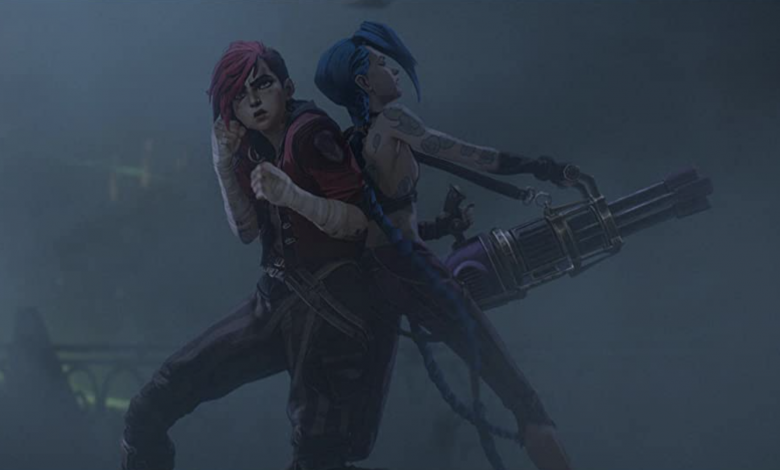Netflix’s Arcane – The Miracle TV Show

Jackson Murphy ’25 / Emertainment Monthly Staff Writer
The words “video game TV show” send a cold shiver down the spine of most video game enthusiasts. In the about 30 years-long history of TV shows and movies based on video games, there has been very little success in terms of actual reviews and quality. In fact, the highest-rated video game film of all time, Werewolves Within, scores at 85% on Rotten Tomatoes and 66/100 on Metacritic, a website that homogenizes individual critic scores into one overall score. However, this film is the exception, not the standard, as the next highest-rated movie, Detective Pikachu, is scored at 68% on Rotten Tomatoes and 53/100 on Metacritic. The exact reason for why is a long discussion, but some automatic difficulty comes with adapting the way video games present stories into a short, few hour long movie form.
The story is a little less bleak with video game TV shows, as the highest-rated (American-made) show is Netflix’s Castlevania. Based on the video game series of the same name, the show ran for four seasons with a Rotten Tomatoes score of 94% and Metacritic score of 71/100. However, this show is again more of an exception than the standard, especially considering that TV shows based on video games are much less common than their film counterparts.
In early March of 2019, Riot Games, the creators of the wildly popular multiplayer game League of Legends, announced a new animated TV show based on the game: Arcane. At 180 million total players, League of Legends is the most popular video game globally, but its in-game story has never been its most substantial aspect. The actual information and lore surrounding characters within the game are usually learned by reading information online versus actually playing the game. While this lore is decently robust, its spread-out nature, plus the usual lack of inclusion within the game, left me and many others interested in the show worried about its quality.
Today, it feels like a sigh of relief to say that Arcane isn’t good; it’s fantastic. Arcane is one of those once in a blue moon TV shows that always had my attention while watching and continuously had me anticipating the next episodes. When I watched and eventually finished Arcane, I was shocked by just how much I had enjoyed it. A video game TV show shouldn’t be this good, but somehow it is.
Now, “somehow” isn’t an accurate way to describe what makes Arcane so good; its story is. While the world of League of Legends is an expansive one, the writers behind Arcane focus on a single city, Piltover, which is divided between its literal upper areas of progress and polish and lower undercity depths. While the idea of upper versus lower class is not new to multimedia, Arcane puts a twist on it, placing its main characters on both sides of the city, giving them their own individual conflicts to face, alongside a single overarching problem connecting them.
Arcane isn’t a simple story of the lower versus upper class despite its setup. As the show progresses, it becomes evident that each side—or better described as level—of Piltover faces problems, but are still highly connected, existing in an almost symbiotic relationship. While the writers behind Arcane put unique spins on the upper versus lower styler story, they even seem to recognize its common use, and instead use this duo as a set piece for characters’ stories to play out, which eventually connect to each other (and the background divide) in a wonderfully natural way.
These mentioned characters and the conflicts they face are really what make Arcane so unique. While characters are essential to any piece of media, they are often just used as a way for the viewer to witness entertaining events. For example, how many people actually watch the Jurassic World films for Chris Pratt’s character versus seeing cool dinosaurs? In Arcane, the show’s entire purpose seems to be exploring its characters versus using them as a way to reach entertaining events. There was not one character that didn’t interest me in seeing how their story and conflicts would play out. Of course, some characters were more interesting than others, not because others were weak, but because they personally felt more connected to me. In fact, almost everyone I’ve talked to about Arcane has had a different favorite character, or characters, from each other, demonstrating just how strong all of the personas of the show are.
However, a review of Arcane can’t be finished without discussing its place as an animated TV show. To put it simply, the animation style and quality of Arcane is stunning. While the studio behind Arcane, Fortiche Productions, is relatively unknown and has a limited resume, the animation quality here rivals the most outstanding studios and its style (a good moment to say in my non-animation expert opinion) surpasses them. The animation Fortiche employs for Arcane involves a beautiful concoction of cell-shaded-esque 3D characters and models, hand-painted backgrounds, and 2D animation for specific effects (like explosions) to create one of the most unique and visually stunning animation styles ever seen.
Arcane feels like a blindly great ray of hope for the video game adaptation scene. Its animation, characters, and story, all equal in extraordinary quality, combine to form one of Netflix’s greatest (at least animated) exclusive shows. The success of Arcane has left me, for the first time, excited to see future adaptations from the League of Legends universe, albeit nervous, as the same quality is a challenging peak to reach.